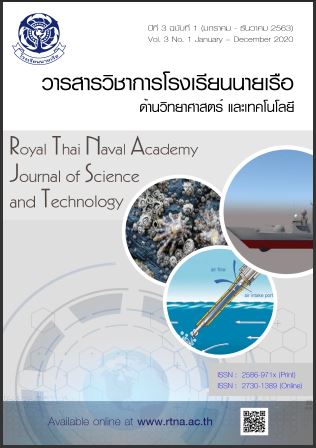การตรวจสอบความบริสุทธิ์ของเมทิลเอสเตอร์ในไบโอดีเซลด้วยทินเลเยอร์โครมาโทกราฟี
Main Article Content
บทคัดย่อ
ไบโอดีเซลประเทศไทยมี 2 มาตรฐานตามประกาศกรมธุรกิจพลังงาน ได้แก่ มาตรฐานไบโอดีเซลสำหรับเครื่องยนต์การเกษตร (ไบโอดีเซลชุมชน) และมาตรฐานไบโอดีเซลประเภทเมทิลเอสเตอร์ของกรดไขมัน (ไบโอดีเซล B100) มาตรฐานไบโอดีเซลดังกล่าวมีความแตกต่างในเรื่องค่าสมบัติสำคัญของไบโอดีเซลแต่ละชนิด จากการศึกษาพบว่าข้อกำหนดคุณภาพของปริมาณเมทิลเอสเตอร์ซึ่งเป็นสารประกอบหลักที่แสดงว่าปฏิกิริยาเกิดสมบูรณ์ ต้องมีค่าร้อยละความบริสุทธิ์ของเมทิลเอสเตอร์อย่างน้อย 96.5 จึงจะจัดเป็นไบโอดีเซล ชนิด B100 ซึ่งในทางเคมีสามารถใช้แสงอัลตร้าไวโอเลต (UV) ที่ความยาวคลื่น 254 นาโนเมตร ส่องไปบนแผ่น TLC (Thin Layer Chromatography) ซึ่งเป็นอุปกรณ์ทางเคมีที่ใช้ทดสอบความบริสุทธิ์ของสาร สิ่งที่ปรากฏคือจุด (spot) ที่ปรากฏภายใต้แสงอัลตร้าไวโอเลต โดยการเปรียบเทียบระหว่าง spot ของไบโอดีเซลตัวอย่าง (unknown) ที่เราสงสัยว่าจะเป็นไบโอดีเซลชนิดใด กับ spot ของไบโอดีเซลมาตรฐาน ซึ่งเป็นไบโอดีเซลชนิด B100 ที่ทราบร้อยละความบริสุทธิ์ที่แน่นอน ผลที่ได้รับคือการใช้แสงอัลตร้าไวโอเลตตรวจสอบความบริสุทธิ์ของไบโอดีเซล ให้ผลสอดคล้องกับการตรวจสอบความบริสุทธิ์ของเมทิลเอสเตอร์โดยใช้เครื่องมือขั้นสูงในห้องปฏิบัติการเคมี และสามารถใช้เป็นวิธีตรวจสอบชนิดของไบโอดีเซลเบื้องต้นได้
Article Details
เนื้อหาและข้อมูลในบทความที่ลงตีพิมพ์ในวารสารวิชาการโรงเรียนนายเรือ ด้านวิทยาศาสตร์และเทคโนโลยี ถือเป็นข้อคิดเห็นและความรับผิดชอบของผู้เขียนบทความโดยตรง ซึ่งกองบรรณาธิการวารสาร ไม่จำเป็นต้องเห็นด้วย หรือร่วมรับผิดชอบใด ๆ
บทความ ข้อมูล เนื้อหา รูปภาพ ฯลฯ ที่ได้รับการตีพิมพ์ในวารสารวิชาการโรงเรียนนายเรือ ด้านวิทยาศาสตร์และเทคโนโลยี ถือเป็นลิขสิทธิ์ของโรงเรียนนายเรือ หากบุคคลหรือหน่วยงานใดต้องการนำทั้งหมดหรือส่วนหนึ่งส่วนใดไปเผยแพร่ต่อหรือเพื่อกระทำการใด ๆ จะต้องได้รับอนุญาตเป็นลายลักษณ์อักษรจากโรงเรียนนายเรือก่อนเท่านั้น
เอกสารอ้างอิง
Antolin G, Tinaut FV, Briceno Y, Castano V, Perez C, Ramirez AI. Optimization of biodiesel production by sunflower oil transesterification. Bioresource Technology. 2002;83(2):111-4.
Bournay L, Casanave D, Delfort B, Hillion G, Chodorge JA. New heterogeneous process for biodiesel production: A way to improve the quality and the value of the crude. Catalysis Today. 2005;106(1-4):190-2.
Van GJ. Biodiesel processing and production. Fuel Processing Technology. 2005;86: 1097-1107.
คณะกรรมาธิการพลังงาน สภาผู้แทนราษฎร. พลังงานทดแทนเอทานอลและไบโอดีเซล. กรุงเทพฯ: แปลนพริ้นติ้ง; 2545.
เมกกะฟิล. แสงยูวีคืออะไร. [อินเทอร์เน็ต]. นนทบุรี: เมกกะฟิล; 2563. [สืบค้นเมื่อ 9 เม.ย. 2563].จาก:http://www.megafil.co.th/index.php?lay=show&ac=article&Id=539644324&Ntype=15
การอ่านแผ่น TLC ภายใต้แสง UV. [อินเทอร์เน็ต]. กรุงเทพฯ: ; 2560. [สืบค้นเมื่อ 10 เม.ย. 2563]. จาก:
https://elife-news.blogspot.com/2017/11/tlc-uv.html
กรมวิทยาศาสตร์ทหารเรือ สำนักงานวิจัยและพัฒนาการทางทหารกองทัพเรือเอกสารวิจัย. โครงการวิจัยและพัฒนาเรื่องเครื่องต้นแบบตรวจติดตามความบริสุทธิ์ของการผลิตไบโอดีเซล. กรุงเทพฯ: กรม; 2555.
ธิติมา รุกขไชยศิริกุล. ปฏิบัติการอินทรีย์เคมี 1. พิมพ์ครั้งที่ 1. กรุงเทพฯ: ภาควิชาเคมี คณะวิทยาศาสตร์ มหาวิทยาลัยรามคำแหง; 2529.


